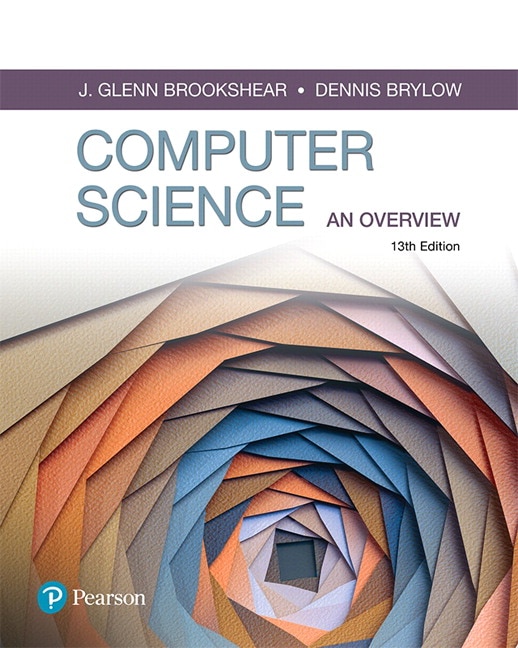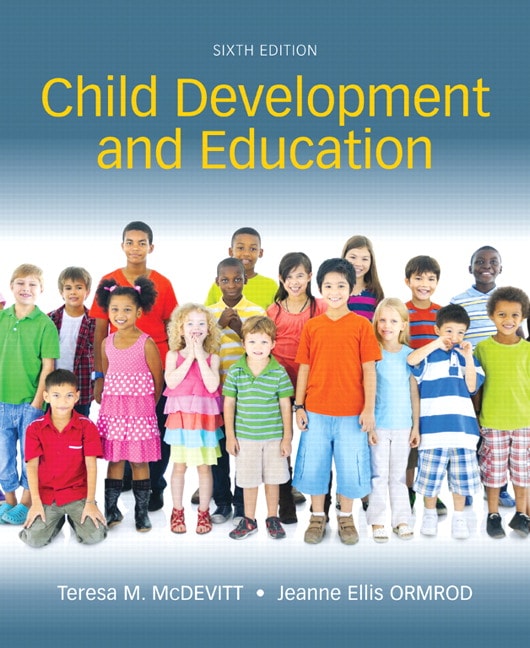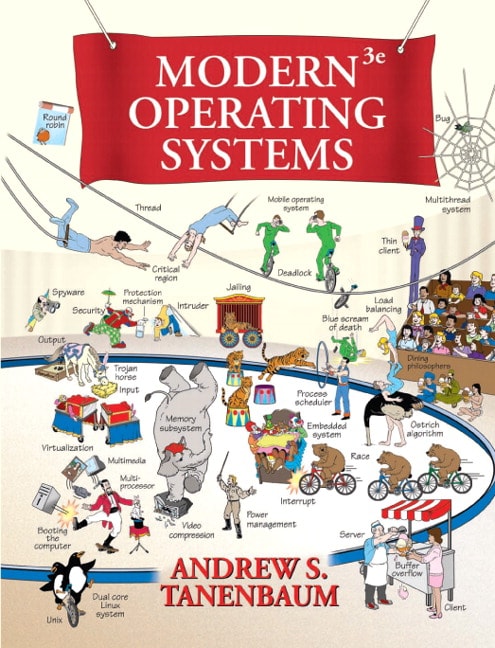Table of Contents
1 INTRODUCTION
1.1 WHAT IS AN OPERATING SYSTEM?
1.1.1 The Operating System as an Extended Machine
1.1.2 The Operating System as a Resource Manager
1.2 HISTORY OF OPERATING SYSTEMS
1.2.1 The First Generation
1.2.2 The Second Generation
1.2.3 The Third Generation
1.2.4 The Fourth Generation
1.3 COMPUTER HARDWARE REVIEW
1.3.1 Processors
1.3.2 Memory
1.3.3 Disks
1.3.4 Tapes
1.3.5 I/O Devices
1.3.6 Buses
1.3.7 Booting the Computer
1.4 THE OPERATING SYSTEM ZOO
1.4.1 Mainframe Operating Systems
1.4.2 Server Operating Systems
1.4.3 Multiprocessor Operating Systems
1.4.4 Personal Computer Operating Systems
1.4.5 Handheld Computer Operating Systems
1.4.6 Embedded Operating Systems.
1.4.7 Sensor Node Operating Systems
1.4.8 Real-Time Operating Systems
1.4.9 Smart Card Operating Systems
1.5 OPERATING SYSTEM CONCEPTS
1.5.1 Processes
1.5.2 Address Spaces
1.5.3 Files
1.5.4 Input/Output
1.5.5 Protection
1.5.6 The Shell
1.5.7 Ontogeny Recapitulates Phylogeny
1.6 SYSTEM CALLS
1.6.1 System Calls for Process Management
1.6.2 System Calls for File Management
1.6.3 System Calls for Directory Management
1.6.4 Miscellaneous System Calls
1.6.5 The Windows Win32 API
1.7 OPERATING SYSTEM STRUCTURE
1.7.1 Monolithic Systems
1.7.2 Layered Systems
1.7.3 Microkernels
1.7.4 Client-Server Model
1.7.5 Virtual Machines
1.7.6 Exokernels
1.8 THE WORLD ACCORDING TO C
1.8.1 The C Language
1.8.2 Header Files
1.8.3 Large Programming Projects
1.8.4 The Model of Run Time
1.9 RESEARCH ON OPERATING SYSTEMS
1.10 OUTLINE OF THE REST OF THIS BOOK
1.11 METRIC UNITS
1.12 SUMMARY
2 PROCESSES AND THREADS
2.1 PROCESSES
2.1.1 The Process Model
2.1.2 Process Creation
2.1.3 Process Termination
2.1.4 Process Hierarchies
2.1.5 Process States
2.1.6 Implementation of Processes
2.1.7 Modeling Multiprogramming
2.2 THREADS
2.2.1 Thread Usage
2.2.2 The Classical Thread Model
2.2.3 POSIX Threads
2.2.4 Implementing Threads in User Space
2.2.5 Implementing Threads in the Kernel
2.2.6 Hybrid Implementations
2.2.7 Scheduler Activations
2.2.8 Pop-Up Threads
2.2.9 Making Single-Threaded Code Multithreaded
2.3 INTERPROCESS COMMUNICATION
2.3.1 Race Conditions
2.3.2 Critical Regions
2.3.3 Mutual Exclusion with Busy Waiting
2.3.4 Sleep and Wakeup
2.3.5 Semaphores
2.3.6 Mutexes
2.3.7 Monitors
2.3.8 Message Passing
2.3.9 Barriers
2.4 SCHEDULING
2.4.1 Introduction to Scheduling
2.4.2 Scheduling in Batch Systems
2.4.3 Scheduling in Interactive Systems
2.4.4 Scheduling in Real-Time Systems
2.4.5 Policy versus Mechanism
2.4.6 Thread Scheduling
2.5 CLASSICAL IPC PROBLEMS
2.5.1 The Dining Philosophers Problem
2.5.2 The Readers and Writers Problem
2.6 RESEARCH ON PROCESSES AND THREADS
2.7 SUMMARY
3 MEMORY MANAGEMENT
3.1 NO MEMORY ABSTRACTION
3.2 A MEMORY ABSTRACTION: ADDRESS SPACES
3.2.1 The Notion of an Address Space
3.2.2 Swapping
3.2.3 Managing Free Memory
3.3 VIRTUAL MEMORY
3.3.1 Paging
3.3.2 Page Tables
3.3.3 Speeding Up Paging
3.3.4 Page Tables for Large Memories
3.4 PAGE LACEMENT ALGORITHMS
3.4.1 The Optimal Page Replacement Algorithm
3.4.2 The Not Recently Used Page Replacement Algorithm
3.4.3 The First-In, First-Out
3.4.4 The Second Chance Page Replacement Algorithm
3.4.5 The Clock Page Replacement Algorithm
3.4.6 The Least Recently Used
3.4.7 Simulating LRU in Software
3.4.8 The Working Set Page Replacement Algorithm
3.4.9 The WSClock Page Replacement Algorithm
3.4.10 Summary of Page Replacement Algorithms
3.5 DESIGN ISSUES FOR PAGING SYSTEMS
3.5.1 Local versus Global Allocation Policies
3.5.2 Load Control
3.5.3 Page Size
3.5.4 Separate Instruction and Data Spaces
3.5.5 Shared Pages
3.5.6 Shared Libraries
3.5.7 Mapped Files
3.5.8 Cleaning Policy
3.5.9 Virtual Memory Interface
3.6 IMPLEMENTATION ISSUES
3.6.1 Operating System Involvement with Paging
3.6.2 Page Fault Handling
3.6.3 Instruction Backup
3.6.4 Locking Pages in Memory
3.6.5 Backing Store
3.6.6 Separation of Policy and Mechanism
3.7 SEGMENTATION
3.7.1 Implementation of Pure Segmentation
3.7.2 Segmentation with Paging: MULTICS
3.7.3 Segmentation with Paging: The Intel Pentium
3.8 RESEARCH ON MEMORY MANAGEMENT
3.9 SUMMARY
4 FILE SYSTEMS
4.1 FILES
4.1.1 File Naming
4.1.2 File Structure
4.1.3 File Types
4.1.4 File Access
4.1.5 File Attributes
4.1.6 File Operations
4.1.7 An Example Program Using File System Calls
4.2 DIRECTORIES
4.2.1 Single-Level Directory Systems
4.2.2 Hierarchical Directory Systems
4.2.3 Path Names
4.2.4 Directory Operations
4.3 FILE SYSTEM IMPLEMENTATION
4.3.1 File System Layout
4.3.2 Implementing Files
4.3.3 Implementing Directories
4.3.4 Shared Files
4.3.5 Log-Structured File Systems
4.3.6 Journaling File Systems
4.3.7 Virtual File Systems
4.4 FILE SYSTEM MANAGEMENT AND OPTIMIZATION
4.4.1 Disk Space Management
4.4.2 File System Backups
4.4.3 File System Consistency
4.4.4 File System Performance
4.4.5 Defragmenting Disks
4.5 EXAMPLE FILE SYSTEMS
4.5.1 CD-ROM File Systems
4.5.2 The MS-DOS File System
4.5.3 The UNIX V7 File System
4.6 RESEARCH ON FILE SYSTEMS
4.7 SUMMARY
5 INPUT/OUTPUT
5.1 PRINCIPLES OF I/O HARDWARE
5.1.1 I/O Devices
5.1.2 Device Controllers
5.1.3 Memory-Mapped I/O
5.1.4 Direct Memory Access
5.1.5 Interrupts Revisited
5.2 PRINCIPLES OF I/O SOFTWARE
5.2.1 Goals of the I/O Software
5.2.2 Programmed I/O
5.2.3 Interrupt-Driven I/O
5.2.4 I/O Using DMA
5.3 I/O SOFTWARE LAYERS
5.3.1 Interrupt Handlers
5.3.2 Device Drivers
5.3.3 Device-Independent I/O Software
5.3.4 User-Space I/O Software
5.4 DISKS
5.4.1 Disk Hardware
5.4.2 Disk Formatting
5.4.3 Disk Arm Scheduling Algorithms
5.4.4 Error Handling
5.4.5 Stable Storage
5.5 CLOCKS
5.5.1 Clock Hardware
5.5.2 Clock Software
5.5.3 Soft Timers
5.6 USER INTERFACES: KEYBOARD, MOUSE, MONITOR
5.6.1 Input Software
5.6.2 Output Software
5.7 THIN CLIENTS
5.8 POWER MANAGEMENT
5.8.1 Hardware Issues
5.8.2 Operating System Issues:
5.8.3 Application Program Issues
5.9 RESEARCH ON INPUT/OUTPUT
5.10 SUMMARY
6 DEADLOCKS
6.1 RESOURCES
6.1.1 Preemptable and Nonpreemptable Resources
6.1.2 Resource Acquisition
6.2 INTRODUCTION TO DEADLOCKS
6.2.1 Conditions for Resource Deadlocks
6.2.2 Deadlock Modeling
6.3 THE OSTRICH ALGORITHM
6.4 DEADLOCK DETECTION AND RECOVERY
6.4.1 Deadlock Detection with One Resource of Each Type
6.4.2 Deadlock Detection with Multiple Resources of Each Type
6.4.3 Recovery from Deadlock
6.5 DEADLOCK AVOIDANCE
6.5.1 Resource Trajectories
6.5.2 Safe and Unsafe States
6.5.3 The Banker’s Algorithm for a Single Resource
6.5.4 The Banker’s Algorithm for Multiple Resources
6.6 DEADLOCK PREVENTION
6.6.1 Attacking the Mutual Exclusion Condition
6.6.2 Attacking the Hold and Wait Condition
6.6.3 Attacking the No Preemption Condition
6.6.4 Attacking the Circular Wait Condition
6.7 OTHER ISSUES
6.7.1 Two-Phase Locking
6.7.2 Communication Deadlocks
6.7.3 Livelock
6.7.4 Starvation
6.8 RESEARCH ON DEADLOCKS
6.9 SUMMARY
7 MULTIMEDIA OPERATING SYSTEMS
7.1 INTRODUCTION TO MULTIMEDIA
7.2 MULTIMEDIA FILES
7.2.1 Video Encoding
7.2.2 Audio Encoding
7.3 VIDEO COMPRESSION
7.3.1 The JPEG Standard
7.3.2 The MPEG Standard
7.4 AUDIO COMPRESSION
7.5 MULTIMEDIA PROCESS SCHEDULING
7.5.1 Scheduling Homogeneous Processes
7.5.2 General Real-Time Scheduling
7.5.3 Rate Monotonic Scheduling
7.5.4 Earliest Deadline First Scheduling
7.6 MULTIMEDIA FILE SYSTEM PARADIGMS
7.6.1 VCR Control Functions
7.6.2 Near Video on Demand
7.6.3 Near Video on Demand with VCR Functions
7.7 FILE PLACEMENT
7.7.1 Placing a File on a Single Disk
7.7.2 Two Alternative File Organization Strategies
7.7.3 Placing Files for Near Video on Demand
7.7.4 Placing Multiple Files on a Single Disk
7.7.5 Placing Files on Multiple Disks
7.8 CACHING
7.8.1 Block Caching
7.8.2 File Caching
7.9 DISK SCHEDULING FOR MULTIMEDIA
7.9.1 Static Disk Scheduling
7.9.2 Dynamic Disk Scheduling
7.10 RESEARCH ON MULTIMEDIA
7.11 SUMMARY
8 MULTIPLE PROCESSOR SYSTEMS
8.1 MULTIPROCESSORS
8.1.1 Multiprocessor Hardware
8.1.2 Multiprocessor Operating System Types
8.1.3 Multiprocessor Synchronization
8.1.4 Multiprocessor Scheduling
8.2 MULTICOMPUTERS
8.2.1 Multicomputer Hardware
8.2.2 Low-Level Communication Software
8.2.3 User-Level Communication Software
8.2.4 Remote Procedure Call
8.2.5 Distributed Shared Memory
8.2.6 Multicomputer Scheduling
8.2.7 Load Balancing
8.3 VIRTUALIZATION
8.3.1 Requirements for Virtualization
8.3.2 Type 1 Hypervisors
8.3.3 Type 2 Hypervisors
8.3.4 Paravirtualization
8.3.5 Memory Virtualization
8.3.6 I/O Virtualization
8.3.7 Virtual Appliances
8.3.8 Virtual Machines on Multicore CPUs
8.3.9 Licensing Issues
8.4 DISTRIBUTED SYSTEMS
8.4.1 Network Hardware
8.4.2 Network Services and Protocols
8.4.3 Document-Based Middleware
8.4.4 File System-Based Middleware
8.4.5 Object-Based Middleware
8.4.6 Coordination-Based Middleware
8.5 RESEARCH ON MULTIPLE PROCESSOR SYSTEMS
8.6 SUMMARY
9 SECURITY
9.1 THE SECURITY ENVIRONMENT
9.1.1 Threats
9.1.2 Intruders
9.1.3 Accidental Data Loss
9.2 BASICS OF CRYPTOGRAPHY
9.2.1 Secret-Key Cryptography
9.2.2 Public-Key Cryptography
9.2.3 One-Way Functions
9.2.4 Digital Signatures
9.2.5 Trusted Platform Module
9.3 PROTECTION MECHANISMS
9.3.1 Protection Domains
9.3.2 Access Control Lists
9.3.3 Capabilities
9.3.4 Trusted systems
9.3.5 Trusted Computing Base
9.3.6 Formal Models of Secure Systems
9.3.7 Multilevel Security
9.3.8 Covert Channels
9.4 AUTHENTICATION
9.4.1 Authentication Using Passwords
9.4.2 Authentication Using a Physical Object
9.4.3 Authentication Using Biometrics
9.5 INSIDER ATTACKS
9.5.1 Logic Bombs
9.5.2 Trap Doors
9.5.3 Login Spoofing
9.6 EXPLOITING CODE BUGS
9.6.1 Buffer Overflow Attacks
9.6.2 Format String Attacks
9.6.3 Return to libc Attacks
9.6.4 Integer Overflow Attacks
9.6.5 Code Injection Attacks
9.6.6 Privilege Escalation Attacks
9.7 MALWARE
9.7.1 Trojan Horses
9.7.2 Viruses
9.7.3 Worms
9.7.4 Spyware
9.7.5 Rootkits
9.8 DEFENSES
9.8.1 Firewalls
9.8.2 Antivirus and Anti-Antivirus Techniques
9.8.3 Code Signing
9.8.4 Jailing
9.8.5 Model-Based Intrusion Detection
9.8.6 Encapsulating Mobile Code
9.8.7 Java Security
9.9 RESEARCH ON SECURITY
9.10 SUMMARY
10 CASE STUDY 1: LINUX
10.1 HISTORY OF UNIX AND LINUX
10.1.1 UNICS
10.1.2 PDP-11 UNIX
10.1.3 Portable UNIX
10.1.4 Berkeley UNIX
10.1.5 Standard UNIX
10.1.6 MINIX
10.1.7 Linux
10.2 OVERVIEW OF LINUX
10.2.1 Linux Goals
10.2.2 Interfaces to Linux
10.2.3 The Shell
10.2.4 Linux Utility Programs
10.2.5 Kernel Structure
10.3 PROCESSES IN LINUX
10.3.1 Fundamental Concepts
10.3.2 Process Management System Calls in Linux
10.3.3 Implementation of Processes and Threads in Linux
10.3.4 Scheduling in Linux
10.3.5 Booting Linux
10.4 MEMORY MANAGEMENT IN LINUX
10.4.1 Fundamental Concepts
10.4.2 Memory Management System Calls in Linux
10.4.3 Implementation of Memory Management in Linux
10.4.4 Paging in Linux
10.5 INPUT/OUTPUT IN LINUX
10.5.1 Fundamental Concepts
10.5.2 Networking
10.5.3 Input/Output System Calls in Linux
10.5.4 Implementation of Input/Output in Linux
10.5.5 Modules in Linux
10.6 THE LINUX FILE SYSTEM
10.6.1 Fundamental Concepts
10.6.2 File System Calls in Linux
10.6.3 Implementation of the Linux File System
10.6.4 NFS: The Network File System
10.7 SECURITY IN LINUX
10.7.1 Fundamental Concepts
10.7.2 Security System Calls in Linux
10.7.3 Implementation of Security in Linux
10.8 SUMMARY
11 CASE STUDY 2: WINDOWS VISTA
11.1 HISTORY OF WINDOWS VISTA
11.1.1 1980s: MS-DOS
11.1.2 1990s: MS-DOS-based Windows
11.1.3 2000s: NT-based Windows
11.1.4 Windows Vista
11.2 PROGRAMMING WINDOWS VISTA
11.2.1 The Native NT Application Programming Interface
11.2.2 The Win32 Application Programming Interface
11.2.3 The Windows Registry
11.3 SYSTEM STRUCTURE
11.3.1 Operating System Structure
11.3.2 Booting Windows Vista
11.3.3 Implementation of the Object Manager
11.3.4 Subsystems, DLLs, and User-mode Services
11.4 PROCESSES AND THREADS IN WINDOWS VISTA
11.4.1 Fundamental Concepts
11.4.2 Job, Process, Thread and Fiber Management API Calls
11.4.3 Implementation of Processes and Threads
11.5 MEMORY MANAGEMENT
11.5.1 Fundamental Concepts
11.5.2 Memory Management System Calls
11.5.3 Implementation of Memory Management
11.6 CACHING IN WINDOWS VISTA
11.7 INPUT/OUTPUT IN WINDOWS VISTA
11.7.1 Fundamental Concepts
11.7.2 Input/Output API Calls
11.7.3 Implementation of I/O
11.8 THE WINDOWS NT FILE SYSTEM
11.8.1 Fundamental Concepts
11.8.2 Implementation of the NT File System
11.9 SECURITY IN WINDOWS VISTA
11.9.1 Fundamental Concepts
11.9.2 Security API Calls
11.9.3 Implementation of Security
11.10 SUMMARY
12 CASE STUDY 3: SYMBIAN OS
12.1 THE HISTORY OF SYMBIAN OS
12.1.1 Symbian OS Roots: Psion and EPOC
12.1.2 Symbian OS Version 6
12.1.3 Symbian OS Version 7
12.1.4 Symbian OS Today
12.2 AN OVERVIEW OF SYMBIAN OS
12.2.1 Object Orientation
12.2.2 Microkernel Design
12.2.3 The Symbian OS Nanokernel
12.2.4 Client/Server Resource Access
12.2.5 Features of a Larger Operating System
12.2.6 Communication and Multimedia
12.3 PROCESSES AND THREADS IN SYMBIAN OS
12.3.1 Threads and Nanothreads
12.3.2 Processes
12.3.3 Active Objects
12.3.4 Interprocess Communication
12.4 MEMORY MANAGEMENT
12.4.1 Systems with No Virtual Memory
12.4.2 How Symbian OS Addresses Memory
12.5 INPUT AND OUTPUT
12.5.1 Device Drivers
12.5.2 Kernel Extensions
12.5.3 Direct Memory Access
12.5.4 Special Case: Storage Media
12.5.5 Blocking I/O
12.5.6 Removable Media
12.6 STORAGE SYSTEMS
12.6.1 File systems for Mobile Devices
12.6.2 Symbian OS File systems
12.6.3 File system Security and Protection
12.7 SECURITY IN SYMBIAN OS
12.8 COMMUNICATION IN SYMBIAN OS
12.8.1 Basic Infrastructure
12.8.2 A Closer Look at the Infrastructure
12.9 SUMMARY
13 OPERATING SYSTEMS DESIGN
13.1 THE NATURE OF THE DESIGN PROBLEM
13.1.1 Goals
13.1.2 Why is it Hard to Design an Operating System?
13.2 INTERFACE DESIGN
13.2.1 Guiding Principles
13.2.2 Paradigms
13.2.3 The System Call Interface
13.3 IMPLEMENTATION
13.3.1 System Structure
13.3.2 Mechanism versus Policy
13.3.3 Orthogonality
13.3.4 Naming
13.3.5 Binding Time
13.3.6 Static versus Dynamic Structures
13.3.7 Top-Down versus Bottom-Up Implementation
13.3.8 Useful Techniques
13.4 PERFORMANCE
13.4.1 Why Are Operating Systems Slow?
13.4.2 What Should Be Optimized?
13.4.3 Space-Time Trade-offs
13.4.4 Caching
13.4.5 Hints
13.4.6 Exploiting Locality
13.4.7 Optimize the Common Case
13.5 PROJECT MANAGEMENT
13.5.1 The Mythical Man Month
13.5.2 Team Structure
13.5.3 The Role of Experience
13.5.4 No Silver Bullet
13.6 TRENDS IN OPERATING SYSTEM DESIGN
13.6.1 Virtualization
13.6.2 Multicore Chips
13.6.3 Large Address Space Operating Systems
13.6.4 Networking
13.6.5 Parallel and Distributed Systems
13.6.6 Multimedia
13.6.7 Battery-Powered Computers
13.6.8 Embedded Systems
13.6.9 Sensor Nodes
13.7 SUMMARY
14 READING LIST AND BIBLIOGRAPHY
14.1 SUGGESTIONS FOR FURTHER READING
14.1.1 Introduction and General Works
14.1.2 Processes and Threads
14.1.3 Memory Management
14.1.4 Input/Output
14.1.5 File Systems
14.1.6 eadlocks
14.1.7 Multimedia Operating Systems
14.1.8 Multiple Processor Systems
14.1.9 ecurity
14.1.10 Linux
14.1.11 Windows Vista
14.1.12 The Symbian OS
14.1.13 Design Principles
14.2 ALPHABETICAL BIBLIOGRAPHY
INDEX












